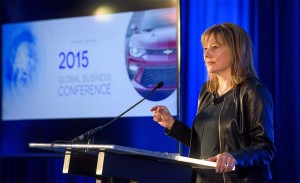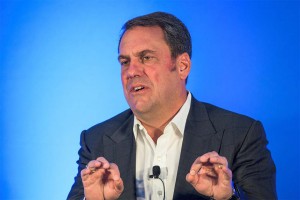With autonomous vehicles, car-sharing programs and alternative powertrains reshaping the auto industry, some manufacturers have begun referring to themselves as “personal mobility companies.” The challenge is finding a way to profit from that transformation, said General Motors CEO Mary Barra, as she opened the maker’s “Global Business Conference” with investors and financial analysts.
General Motors is exploring ways to expand the services it offers customers around the world and expects to invest $5 billion in the effort as part of an effort to meet the competition from new challengers such as Apple, Google and Tesla, Barra said, during the conference at the GM Proving Grounds an hour outside Detroit.
“We’re working to redefine our relationship with customers and personal mobility,” Barry explained, adding that “We want to own that relationship inside and outside the vehicle.”
There’s a general consensus that the automotive industry is facing dramatic change. Some observers question whether autonomous vehicles and car-sharing programs will lead to a decline in new car sales over the coming decades. Meanwhile, consumers are demanding the same sort of technologies in their vehicles normally found in their homes and offices.
(Autonomous vehicle technology coming to market faster than many had expected. Click Here for the story.)
GM is looking to profit from these changes, developing new revenue streams from areas such as alternative transportation. Like competitors such as Ford and Mercedes-Benz, GM has begun experimenting with ways to participate in carsharing programs. Its OnStar telematics subsidiary has already partnered with RelayRides, a service that lets motorists make their vehicles available for short-term rentals, for example.
During the Thursday meeting, GM announced what it called the “Let’s Drive” program in New York City. It will be available to eligible residents of The Ritz Plaza, a 479-unit luxury apartment building near Central Park, explained to Mike Ableson, the vice president of strategy. Residents of the Ritz Plaza will have access to a GM vehicle for three hours each month, noted Abelson. The vehicles are stored at an offsite garage and residents can purchase more time in the vehicle at a nominal rate, he said.
Let’s Drive could serve as a prototype for carsharing projects in other urban areas, Abelson added.
(Tomorrow’s cars may be almost unrecognizable. Click Here for more.)
Barra said part of the $5 billion GM plans to spend in the next five years will be invested not only in new business ventures but also new technologies such as fuel cells and materials that can help reduce the weight of vehicles to help improve fuel economy.
GM’s strong financial position will clear the way for the new investments, Barra said. “We’re on track to hit all of its financial targets for 2015 and 2016, which includes making its struggling European operations profitable again next year. “We have a terrific product portfolio at Opel,” she said.
Barra also GM plans to experiment with various ideas such as electric bikes to see what actually appeals to customers looking for alternatives to the personal car.
“The convergence of rapidly improving technology and changing consumer preferences is creating an inflection point for the transportation industry not seen in decades,” Barra said in her remarks opening the conference. “Some might find this massive change to be daunting, but we look at it and see the opportunity to be a disruptor,” she added.
“It’s a plan that leverages our experience,” said Barra, who stressed that building cars and trucks will remain at the heart of GM’s business. “We remain focused on our core business.”
That said, Barra also acknowledged that the car business is highly “cyclical,” and requires keeping a tight lid on costs.
Mark Reuss, GM executive vice president for product development, said GM plans to reduce its material costs – the money its spends for steel, aluminum, rubber and plastic – by about $2 billion over the next five years by reducing the weight of its vehicles and re-investing the saving into projects such as autonomous vehicles.
(Nissan, Enterprise team up on college carsharing program. Click Here to learn more.)
“We are on the cusp of a sea change that will change the business model for the auto industry. We are one of the companies leading the shift,” he said.
Reuss said GM has been working on autonomous vehicle for several years. “We’re not doing this as a publicity stunt. This is the great disruptor and we’re going to ready for it,” he said.
The maker will launch its new Super Drive technology next year on the new Cadillac CT6 flagship sedan. That will allow motorists to drive hands-free on limited access highways. More advanced systems will follow, GM officials have promised.
GM is by no means the only maker aiming to capitalize on the coming changes in the automotive world. Nissan, Mercedes-Benz and Ford have become active in carsharing programs, and Ford CEO Mark Fields has made a point of saying his company is now in the “personal mobility business.”
(Paul A. Eisenstein contributed to this report.)



I see a lot of auto companies who are going to be very disappointed with AVs and the lack of consumer interest in same. GM is trying to cover all of the possibilities so they can maintain sales in a changing world. Ford is even selling bicycles. Maybe we’ll return to horse and carriage in due time?